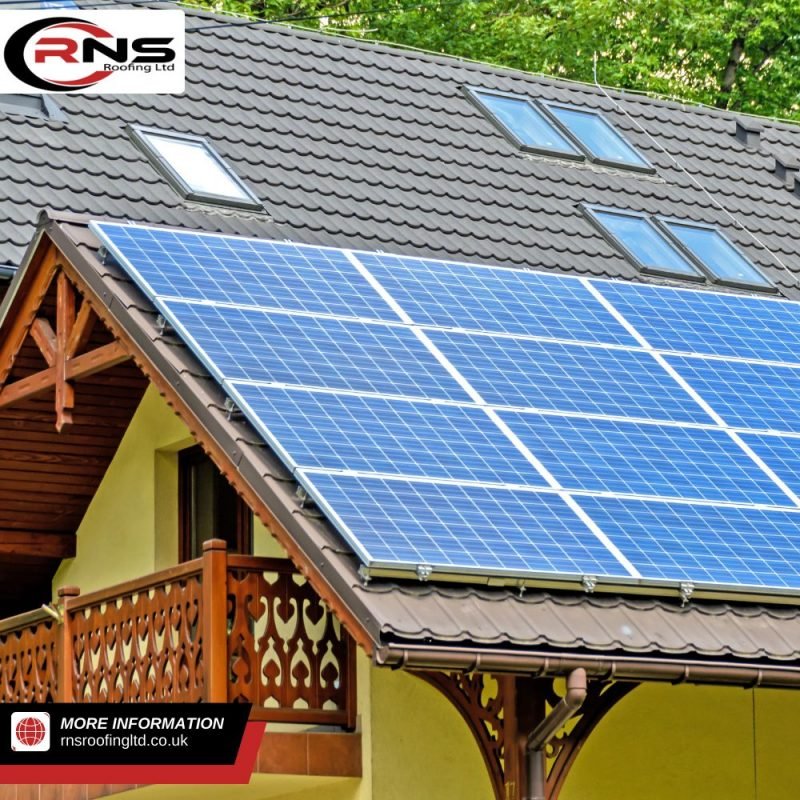As energy bills continue to rise, more homeowners are considering solar energy as an affordable, eco-friendly alternative. Installing solar panels on your roof can significantly lower electricity costs while reducing your carbon footprint. By following these simple steps, you can learn how to install solar panels on roofs and start harnessing the power of the sun.
Assessing Your Roof’s Solar Potential
Before starting your solar panel installation, you must evaluate whether your roof is suitable. Key factors include the roof’s orientation, pitch, surface area, and structural integrity.
Optimal Roof Orientation and Pitch
A south-facing roof is ideal, as it receives the most sunlight throughout the day. A roof tilted at an angle between 30 and 40 degrees will provide maximum solar energy output. East and west-facing roofs can also be effective, though energy production may be slightly lower. North-facing roofs, however, are not suitable for solar panels in the UK.
Roof Size Requirements for Solar Panels
For the average household, you’ll need between 200 and 500 square feet of roof space to install a solar panel system with a capacity of 3 to 8 kilowatts. Ensure there are no obstructions such as chimneys, skylights, or vents that could cast shadows or interfere with installation.
Structural Integrity of the Roof
Your roof must be able to support the weight of the solar panels. Most roofs with standard tiles or slate installed within the last 20 years should be adequate. Older roofs may require structural reinforcements, so it’s advisable to get an engineer’s assessment if your roof is over two decades old.
Preparing Your Roof for Solar Panels
By assessing your roof’s characteristics, you’ll determine if it is ready for solar panels or if any adjustments are needed. Fixing any issues beforehand will make your installation process smoother.
Choosing the Right Solar Panels
Selecting the correct solar panels is vital for meeting your energy needs and ensuring they fit your roof’s dimensions. Solar panel options vary in efficiency and cost.
Crystalline Silicon Panels
These are the most common and affordable solar panels:
- Monocrystalline panels: Highly efficient, converting 15-20% of sunlight into electricity. They are slightly more expensive.
- Polycrystalline panels: Slightly less efficient, converting 13-16% of sunlight. They are more affordable.
Thin-Film Panels
Made from amorphous silicon or cadmium telluride, these panels are less efficient (10-13%) but are lightweight and flexible, making them ideal for curved or irregular roofs. However, they require more roof space to generate the same amount of power.
When choosing your panels, consider your average electricity consumption, budget, and available roof space.

Obtaining Permits and Incentives for Residential Solar
You must obtain the proper permits and incentives to install solar panels on your roof. This step is crucial to ensure your system is safe, up to code, and eligible for tax credits or rebates.
Permits
Building permits are required for most residential solar installations. These permits ensure that the installation meets safety standards and local building codes. Permits are obtained through your local building department, typically part of your city or county government. The permits required will depend on the specifics of your solar panel system, but will likely include both electrical and structural permits.
Incentives
Federal, state, and local incentives are available for residential solar installations. The main incentives are tax credits, rebates, and net metering.
The Federal Solar Investment Tax Credit
The federal solar investment tax credit (ITC) allows you to deduct 30% of the cost of installing a residential solar energy system from your federal taxes. The ITC applies to solar photovoltaic (PV) and heating and cooling systems.
Solar Panel Installer Reward Program
Many states and utilities also offer solar panel installation rebates or other financial incentives. These rebates will reduce the overall cost of your system. Check with your state energy office and local utility to see the available rebates.
Net Metering Programs for Residential Solar Panels
Net metering programs allow solar panel owners to receive credits for excess energy their panels produce. These credits can be used when your system is not producing enough energy. Most states require utilities to offer net metering programs for residential solar customers. Net metering can significantly offset your electric bills.
Installing Solar Panels on Your Home: Planning for Its Long-Term Benefits
Obtaining the necessary permits and taking advantage of available incentives are important steps to installing solar panels in your home. While the permit process can require time and paperwork, the long-term financial and environmental benefits of going solar make it worthwhile. With some research into your local regulations and programs, you’ll be well on your way to powering your home with the sun.
Hiring Professional Installers vs DIY Installation
Deciding whether to install solar panels yourself or hire professional installers depends on your budget and skill level.
DIY Solar Panel Installation
If you’re comfortable with construction and electrical work, DIY installation can save on labour costs. However, it requires safety equipment and the right tools. Keep in mind that a DIY installation may void certain warranties, and connecting the system to your electrical service should be done by a certified electrician.
Professional Installation
Hiring a professional ensures that your solar panels are installed safely and optimally positioned to maximise energy production. Most installers also handle the necessary permits and paperwork. Professional installers often offer warranties on their workmanship, giving you peace of mind.
Step-by-Step Guide to Installing Solar Panel on Roof
Once you have purchased solar panels and the necessary components, you can install them on your roof. Carefully following each step will ensure the panels are securely installed and functioning properly.
Prepare the Roof
Before installing the panels, inspect your roof for leaks or damage and repair as needed. The roof should be less than 10 years old to maximize the system’s lifespan. Clear the area of any debris. You will mount the panels on your south-facing roof, so ensure no obstructions are blocking direct sunlight.
Install the Racking System
The racking system secures the panels to your roof. Install base rails and then attach vertical posts that will hold the panels. Secure everything to your roof following the instructions for your specific system. Use a chalk line to keep the posts straight.
Connect the Panels
Carefully place the first panel in the racking system and secure it with clamps. Connect that panel to the next panel in the row using MC4 connectors to join the wires. Continue adding panels and connecting them until the row is complete. Repeat the same process for any additional rows of panels.
Connect to the Inverter
Run the wires from the solar panels to your inverter. The inverter converts your home’s DC power from the panels to AC power. Connect the wires from the panels to the inverter according to the labels or diagram provided in your inverter instructions. Ensure all connections are tight and secure.
Connect to Your Electrical Service
Connect the output wires from the inverter to your home’s main electrical service panel to provide power to your home. Have an electrician connect the wires to avoid any safety issues. Once connected, your solar panel system will provide free renewable energy and reduce your electric bills!
Following these steps carefully and methodically will ensure your DIY solar panel installation is successful and provides you with energy independence for years to come. Let the power of the sun brighten your day and your wallet.
Conclusion
You now have all the knowledge and tools needed to harness the sun’s power and generate electricity. While the process requires technical skills and physical labour, the rewards of lower energy bills and a greener footprint are well worth the effort. Take your time to ensure each step is done properly and safely. Once your solar panels are operational, you’ll join the growing number of homeowners, achieving greater energy independence and sustainability through solar energy. The sun rises each day to give us a clean, abundant source of power – all you need is the determination to put that power on your roof.
People Ask Questions About How To Install Solar Panels On Roof
How do I determine if my roof is suitable for solar panels?
Start by assessing your roof’s sunlight exposure and checking for any shading from nearby structures or trees. Additionally, considering the roof’s age and condition as a solid foundation is crucial for solar panel installation.
What is the first step in installing solar panels on my roof?
The initial step involves a site assessment by a solar professional. They will evaluate your roof, and shading issues, and calculate your energy needs to design an optimal solar system for your home.
Do I need any special permits to install solar panels on my roof?
Yes, typically. The requirements vary by location, so you must check with your local government or municipality for specific regulations and permits needed for solar panel installations.
Can I install solar panels on a flat roof?
Absolutely! Flat roofs are suitable for solar panel installations. A mounting system is used to angle the panels for better sun exposure in such cases.

